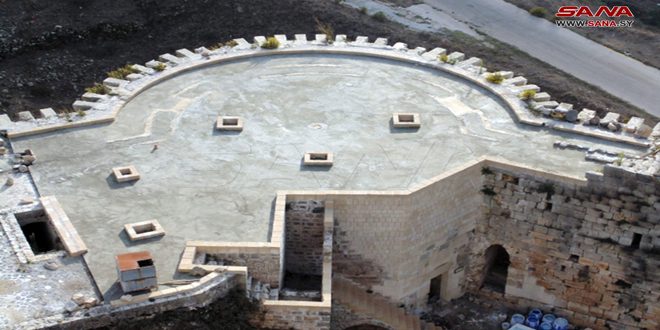Work is currently underway to implement the third phase of the Memorandum of Understanding which included the reinforcement of the northern wall of the Southern Stable overlooking the water trench in Qal’at al-Hosn of Homs. The agreement was signed in 2021 between the General Directorate of Antiquities and Museums and the Patriarchate of Antioch and the rest of the East for the Syriac Orthodox, represented by the Saint Ephrem the Syrian Authority.
The director of the castle, Eng. Hazem Hanna, indicated in a statement to SANA that during the past year, the first and second phases of the memorandum were completed. These works included the main facade works overlooking the trench of the Zahir Baybars Tower, its main gate, the staircase block leading to the roof of the tower, the staircase block leading to the Qalawun Tower, the staircase gate block leading to the western Mamluki portico, and the surrounding facade, as well as the completion of the damaged northern section north of the church tower, and the implementation of a new isolation system and rain drain.
He indicated that the memorandum aims to cooperate and contribute to the study, documentation, restoration, and preservation of Syria’s archaeological heritage, during which the work was distributed in three stages.
Hanna pointed out that the work carried out in the castle by the Directorate General of Antiquities and Museums included the restoration of the facade of the reserve corridor located in the inner castle yard to secure tourists’ visits and restoration of the entrance to the Knights Tower, re-paving and carving the pillar stones rehabilitating the tourist and cultural path of the castle, executing iron doors and windows for the Bint Al-Malik Tower and investing it as a cafeteria for visitors, and lighting the first stable.
With regard to the work of the joint Syrian-Hungarian mission operating in the castle, Hanna pointed out that during the past year the Mission had carried out a series of actions, the most important of which was the documentation of the collapsed stones including stone ornaments , the systematic collection of parts and the use of the numbering system for those stones, as well as the installation of wall drawings in the church tower.
Amal Farhat

